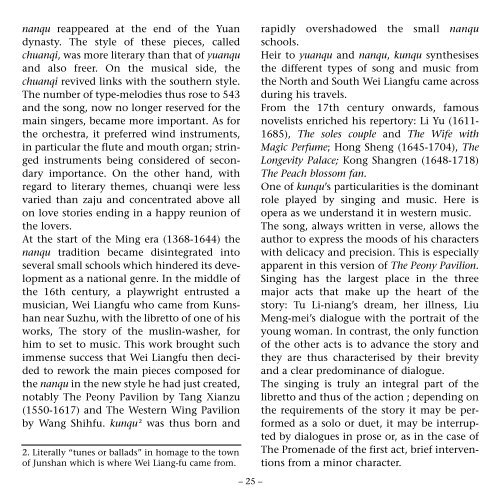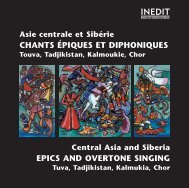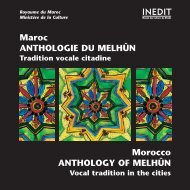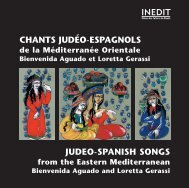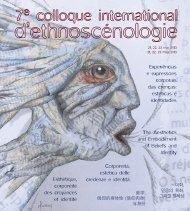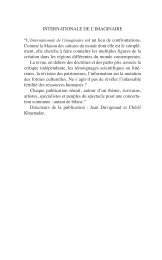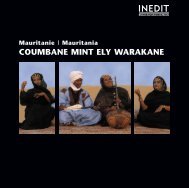le pavillon aux pivoines - Maison des Cultures du Monde
le pavillon aux pivoines - Maison des Cultures du Monde
le pavillon aux pivoines - Maison des Cultures du Monde
You also want an ePaper? Increase the reach of your titles
YUMPU automatically turns print PDFs into web optimized ePapers that Google loves.
nanqu reappeared at the end of the Yuan<br />
dynasty. The sty<strong>le</strong> of these pieces, cal<strong>le</strong>d<br />
chuanqi, was more literary than that of yuanqu<br />
and also freer. On the musical side, the<br />
chuanqi revived links with the southern sty<strong>le</strong>.<br />
The number of type-melodies thus rose to 543<br />
and the song, now no longer reserved for the<br />
main singers, became more important. As for<br />
the orchestra, it preferred wind instruments,<br />
in particular the flute and mouth organ; stringed<br />
instruments being considered of secondary<br />
importance. On the other hand, with<br />
regard to literary themes, chuanqi were <strong>le</strong>ss<br />
varied than zaju and concentrated above all<br />
on love stories ending in a happy reunion of<br />
the lovers.<br />
At the start of the Ming era (1368-1644) the<br />
nanqu tradition became disintegrated into<br />
several small schools which hindered its development<br />
as a national genre. In the midd<strong>le</strong> of<br />
the 16th century, a playwright entrusted a<br />
musician, Wei Liangfu who came from Kunshan<br />
near Suzhu, with the libretto of one of his<br />
works, The story of the muslin-washer, for<br />
him to set to music. This work brought such<br />
immense success that Wei Liangfu then decided<br />
to rework the main pieces composed for<br />
the nanqu in the new sty<strong>le</strong> he had just created,<br />
notably The Peony Pavilion by Tang Xianzu<br />
(1550-1617) and The Western Wing Pavilion<br />
by Wang Shihfu. kunqu 2 was thus born and<br />
2. Literally “tunes or ballads” in homage to the town<br />
of Junshan which is where Wei Liang-fu came from.<br />
–25–<br />
rapidly overshadowed the small nanqu<br />
schools.<br />
Heir to yuanqu and nanqu, kunqu synthesises<br />
the different types of song and music from<br />
the North and South Wei Liangfu came across<br />
<strong>du</strong>ring his travels.<br />
From the 17th century onwards, famous<br />
novelists enriched his repertory: Li Yu (1611-<br />
1685), The so<strong>le</strong>s coup<strong>le</strong> and The Wife with<br />
Magic Perfume; Hong Sheng (1645-1704), The<br />
Longevity Palace; Kong Shangren (1648-1718)<br />
The Peach blossom fan.<br />
One of kunqu’s particularities is the dominant<br />
ro<strong>le</strong> played by singing and music. Here is<br />
opera as we understand it in western music.<br />
The song, always written in verse, allows the<br />
author to express the moods of his characters<br />
with delicacy and precision. This is especially<br />
apparent in this version of The Peony Pavilion.<br />
Singing has the largest place in the three<br />
major acts that make up the heart of the<br />
story: Tu Li-niang’s dream, her illness, Liu<br />
Meng-mei’s dialogue with the portrait of the<br />
young woman. In contrast, the only function<br />
of the other acts is to advance the story and<br />
they are thus characterised by their brevity<br />
and a c<strong>le</strong>ar predominance of dialogue.<br />
The singing is truly an integral part of the<br />
libretto and thus of the action ; depending on<br />
the requirements of the story it may be performed<br />
as a solo or <strong>du</strong>et, it may be interrupted<br />
by dialogues in prose or, as in the case of<br />
The Promenade of the first act, brief interventions<br />
from a minor character.


